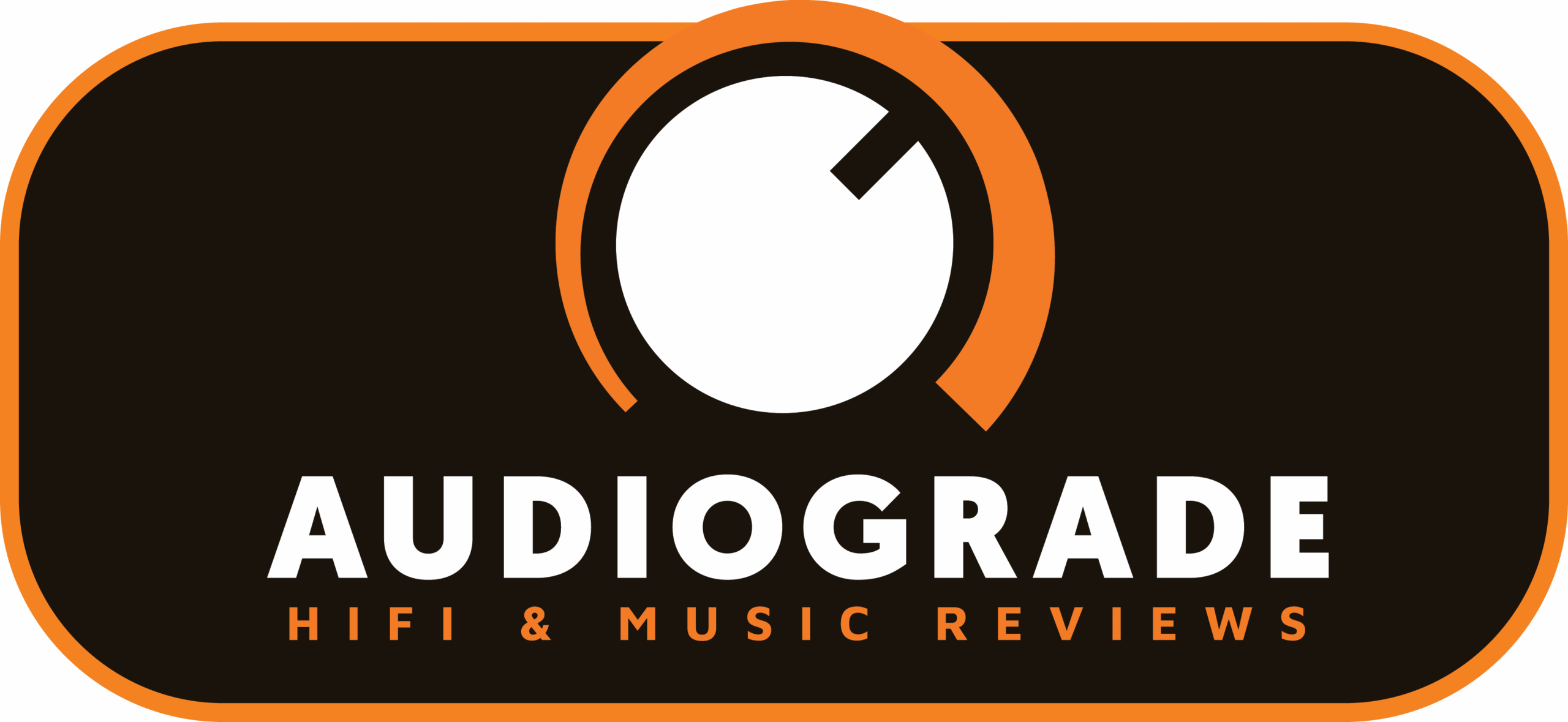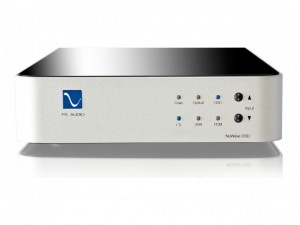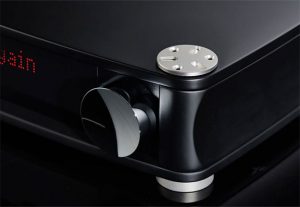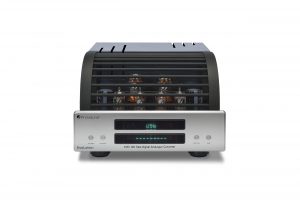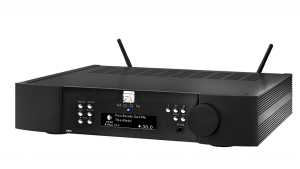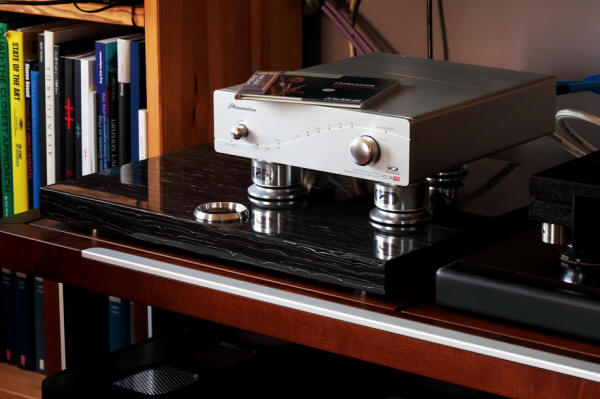
When I think about Phasemation I see a picture in front of my eyes of an older gentleman, the CEO of this company, standing next to the TechDAS Air Force One turntable gently lowering stylus to the groove. That's a picture, to be exact, from a Stereo Sound magazine, and since the size of that picture is quite small I can't be quite sure but it seems that it's a stylus of either his top cartridge PP-1000, or its predecessor P-1G. Phasemation, a company that has a separate brand on Japanese market called Phase-Tech, is widely recognized as an "analogue specialist", as they've been providing customers for years with excellent cartridges and phonostages.
Also the other above mentioned company, TechDAS, is widely recognized as an analogue specialist because of their fantastic One and Two turntables (I know they work on new models—entry level Three and a new flagship Zero). But the fact is that both these brands offer also headphone amplifiers and D/A converters, so not only turntable related products. So why do these brands have such products in their portfolios? At first answer might seem hard to find but only if one doesn't know much about quite specific Japanese market that combines a lot of "classic" products with a some futuristic ones. Maybe that's why this "hi-tech" country rejected audio files as music medium for so long but finally when files playback reached certain (high) level of performance it quickly became widely accepted, or one could think so basing for exampa files player, or a computer and D/A converter. So it seems possible that these two seemingly totally different worlds could be, on some level, coherent and complimentary.
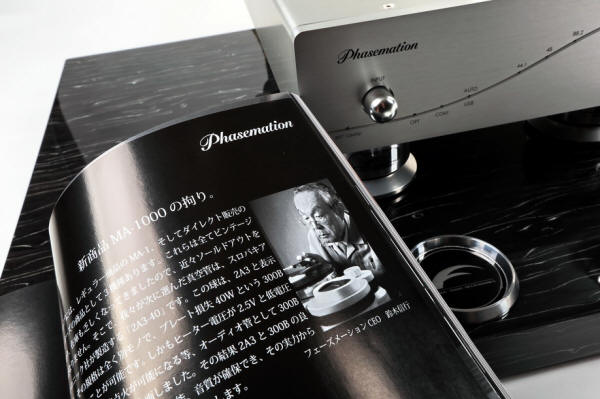
One of these products that don't really fit into Phasemation's "analogue" image is a HD-7A192 D/A Converter. There are few versions of this device and one can find it only on Japanese web-page of Phase-Tech, but it sports something that immediately attracts attention: a digital K2 filter.
This D/A Converter uses a special algorithm to convert 16-bit signal into 20-bit one. Most audiophiles heard about it because of famous JVC CDs - XRCD/XRCD2/XRCD24, but also K2 and K2 HD. These CDs are prepared in a special way using K2 D/A converters, K2 converters, K2 de-jitter circuits, and finally a special K2 laser that cuts a CD matrix.
But the fact is that K2 was firstly used as a D/A converter to play music. It was invented by JVC and Victor Musical Industries in 1987, and at first it was used exclusively in JVC's CD Players. Today few more companies use them including Reimyo in their DAP-999EX Limited D/A Converter, and Phasemation. It is not widely used because of limited quantity if JVC8009 chips, and because Japan Victor Company is quite reluctant when it comes to granting a license for using an adequate logo.
This DAC sports two S/PDIF inputs, a coaxial RCA and optical Toslink. The former accepts signal up to 24-bits and 192kHz, the latter up to 24/96. There is another input, important enough to have it described already on the packaging as: "USB Audio Interface". This input is build around Xilinx chip that accepts PCM signal up to 32-bits and 192kHz.
The K2 processor is, at least for me, the most important element of this device. In Reimyo devices it works all the time. In Phasemation it can be switched off. When activated a green LED turns on. It's color might change to red which indicates that K2 isn't working but a 4x synchronous upsampling has been activated. Upsampling is active also when K2 is on.
At the back besides digital inputs and analogue outputs there are two more BNC sockets. One of them can be used to send a synchronization signal to a compatible CD Transport. But even more important one is the one that allows connection with external 10 MHz master clock.
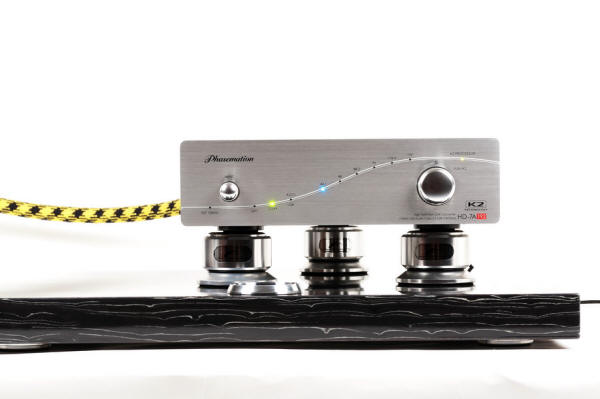
You might remember our coverage of Cracow Sonic Society's meeting with Mr Raveen Bava, who presented a dCS Vivaldi digital system? If you don't remember (or never read it) I strongly encourage you to read it (see HERE). One of the most important elements of this four-box, 400.000 PLN system was an ultra-precise master clock. This solution is widely used in professional studios, where different devices have to be synchronized with a single master clock. All of them sport proper inputs and there are manufacturers who offer high quality external master clocks that can be used for this purpose. JVC followed the same approach in their K2 mastering system, and used K2 master clock for all elements of the system. The newest version of K2 system, for XRCD24, includes "Rubidium K2 Clock".
Why did they use it? Because they learned that a proper master clock helped to reduce jitter in the device and thus to improve sound. Audiophiles quickly learned this trick and started to use professional master clocks in their systems but then manufacturers caught up and delivered products designed for audiophile systems. Nowadays it is hard to imagine systems from dCS, or Esoteric without external master clock. An interesting fact—most companies offering master clocks for audiophile systems come from... Japan. There are not so many of them of course, but Phasemation is one of them. They offer their HD-7Rb (10 MHz Rubidium Master Clock Generator) that sports same clock as used by JVC, and it costs twice as much as the reviewed D/A converter. The symbol of an atom on a front plate might suggest that it is in fact a Rubidium Atomic Clock, used in Universal Japan studios. A proper logo one can find on many CDs from this label, for example on Jazz The Best series. Unfortunately during this test Phasemation Master Clock was not available.
If you want to read more about K2 see HERE
SOUND
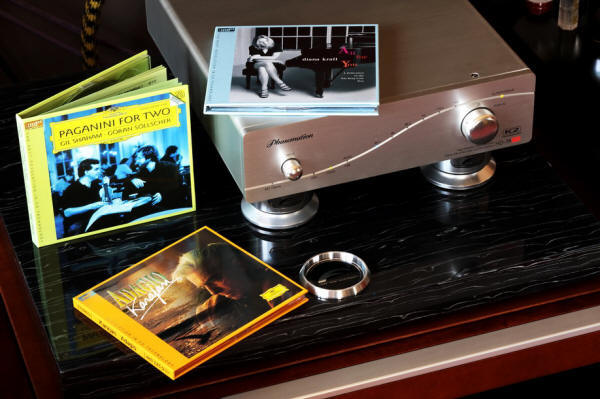
Recording used during test (a selection):
• Paganini For Two, Gil Shaham, Göran Söllscher, Deutsche Grammophon/Universal Music Ltd, Taiwan 480 246-5, XRCD24 (1993/2009).
• Aquavoice, Memoris, Generator GEN CD 011, CD (2009).
• Czesław Niemen & Akwarele, Czy mnie jeszcze pamiętasz?, Polskie Nagrania MUZA/Polskie Nagrania PNCD 1572, CD (1968/2014).
• David Gilmour, On An Island, EMI Records 3556952, CCD (2006).
• Diana Krall, All for You, Impulse!/JVC 532 360-9, XRCD24 (1996/2010).
• Elton John, Goodbye Yellow Brick Road, Mercury/Universal Music LCC UICY-40025, Platinum SHM-CD (1973/2013).
• John Coltrane, Expression, Impulse!/MCA Victor MVCZ-39, "Master of Jazz", K2 CD (1967/1996).
• Karajan, Adagio, Deutsche Grammophon/Universal Music Ltd, Taiwan 480 245-9, XRCD24 (2010).
• Laurie Anderson, Big Science, Nonesuch 79988-5, "Expanded and Remastered for the 25th Anniversary"CD (1982/2007).
• Martin Krotochwil & Jazz Q, Temmné Slunce, soundtrack, GAD Records GAD CD 018, CD (1980/2014).
• Mike Oldfield, Man On The Rocks, Virgin/Universal Music LCC UICY-15274, SHM-CD (2014).
• Skrzek & Rudź, The Stratomusica Suite, Generator GEN CD 032, CD (2014).
• Talk Talk, Spirit of Eden, EMI Records 8571292, CD (1988/1997).
I have no problem with stating that under certain circumstances the D/A converter under review might be the only one you'll ever need. It is not the best DAC I know, far from it actually. It is easy to discover all choices its designer made and then to assess them by yourself. What's more—it is also easy to tell what exactly one pays for sometimes even several times more money when buying top quality device of this kind. But still from the moment I started my sessions with HD-7A192 as well as when I finished them I was certain that this was a well thought through, finished design that required no tweaks, upgrades or whatsoever.
It might not be clear to everyone at first. No offense please. I simply think that to assess products from such specialized market niche like high end audio one needs a lot of experience in it. If one's experience is based on listening to DAC's from manufacturers like Arcam, Cambridge-Audio, Pro-Ject, Music Hall and others like that—that are very good but only at their price level—one might find Phasemation's sound indistinct. But if one has a lot of experience with high-end systems and one realizes quickly what all these Arcams, Pro-Jects and other lack to enter high-end world, and also why this solid-state converter fits very well into a portfolio of a company offering very expensive cartridges, phonostages and powerful, tube amplifiers.
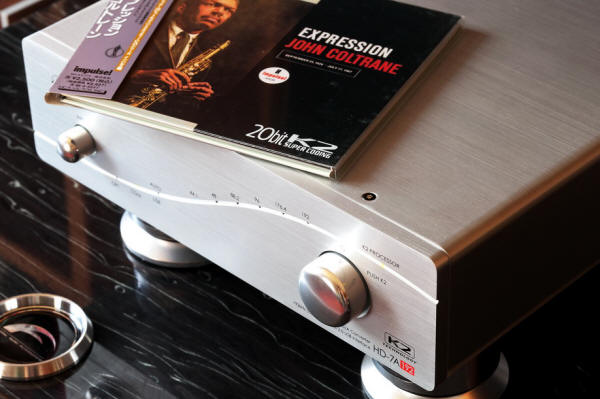
I'll get back to that bit later but I want to make one thing very clear from the beginning—I assessed this DAC with K2 processor on. It wouldn't be fair to say that without it this DAC wasn't any good. K2 is not a magical trick, it is supposed to improve already very good input signal. You know what they say: sh#t in sh#t out no matter what you do with it in between. If you put sh.t in than all you can do is to "pack" it nicely but it still will be a nicely packed sh.t. So this DAC is a very good device but it is K2 that gives the sound the final touch, makes the sound more sophisticated, "noble" and it is K2 that allows me to say that for some people this might be the only DAC they'll ever need.
It offers very smooth and dense sound. That's kind of proprietary JVC feature, that I recognized from Reimyo converters that sport K2 processor, and from XRCD and K2 CDs. An interesting thing—the newest CDs of this kind, the K2HD, offer less of this density (that might be perceived almost as euphony) than their predecessors.
Euphony in case of HD-7A192 is bit of a too strong word but I still would like to use it as it explains best the direction of thinking I'd like to invite you to chose here. Phasemation is capable of "extracting" from any recording some things that usually gets buried under many other more "significant" elements. The most important of them is the "air" that is always present during recording. It manifests its presence by a low level noise and by "ambiance". And all the noise from microphones and tape becomes to make sense. One can hear them better, which some might interpret as a bad thing, noise is not a good thing, right? It is obvious that noise is an enemy of high quality sound. But the noise I'm talking about is an inseparable part of the signal that we have to reproduce at OUR side of the chain. So it has to be reproduced equally well as the rest of the signal.
K2 used in HD-7A192 does a fabulous job at that. All the noise that comes from tape and microphones should be interpreted by the device as any other part of the signal and how it deals with that proves the quality and value of particular device. If these elements are somewhat emphasized, or sound too bright there is work to be done, it should be eliminated. Such a system would have an emphasis in the upper part up the range and that's something I can not tolerate, that's a thing that totally spoils music. When, on the other hand, treble is rolled off it is also wrong but such a sound with limited resolution is easier to accept for many people than a too bright one.
To be clear—I don't listen to noise, but it help me to establish some fundamental facts concerning system, particular device and/or recording. There is no emphasis on treble here. Japanese converter offers slightly rounded sound with a hint of natural warmth. That's a coloration, all right, but it is so small that it could easily be interpreted rather as sonic character than coloration. I could describe bass in a similar way. There is a lot of it if only particular recording allows it, it's colorful, tuneful, with a nice slam. But, same as the treble, it's a bit rounded. And, again the same as treble, it's extension could be a bit better as it isn't as good as presented by for example Ayon Audio Sigma that I reviewed recently for EnjoyTheMusic.com. But I said it was a complete sound, right? Right, it is! As any audio device also this one has some limitations that have been composed into DAC's performance which in general voids these limitations.
Everything one could hold against this DAC goes away because of its smoothness, richness and impressive resolution of low level signals. There is nothing in this sound that causes immediate "wow" effect, nothing demands listeners attention and yet when one starts to listen one dives deep into music and nothing else matters. Yes, I did start my listening sessions with XRCD and K2/K2HD discs from my collection. I concentrated on those that I got directly from Mr Kazuo Kiuchi, when he visited us in Cracow (see HERE). Mr Kiuchi's involvement, also financial one, in this system is well known, and you can find his name on many covers of XRCD24sstating his as a producer. That is I value so much discs with his personal inscription for me. I started with these CDs and I got what I'd expected—some sort of "compatibility" between these discs and this DAC.
Soon enough I found out that limiting my sessions to K2 CDs was not necessary. Everything I loved so much about this performance—amazing depth not only of the whole recording/soundstage but also of individual sounds—I found also while listening to non-K2 recordings. It worked even with such a poor (technically!) recordings like Mike Oldfield's Man On The Rocks, his newest album that I got in, hypothetically, best possible version - SHM-CD, straight from Japan. Even this version doesn't really help with brightness and compression. It might even make it worse to listen. But still, while played through Phasemation it sounded at least OK, with more precise, deeper, more "pleasant" images. And vocal wasn't so irritating any more.
On the other hand with small masterpieces like Czesław Niemen and Akwarele's Czy mnie jeszcze pamiętasz? new remaster prepared by Jacek Gawłowski... it sounded amazing, beautiful. There was this natural softness and amazing ability to differentiate timbre, great spacing and precise imaging. That's what Phasemation does so well!
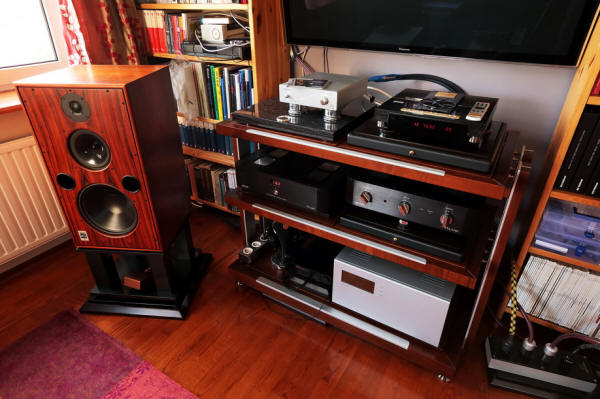
Summary
Any ideas that are supposed to lead to improvement of a Red Book sound seem, in times of HD Audio, obsolete. Why would someone improve something that is a "closed system" while at the same time we have at our disposal a signal that offers much better parameters, that is there within grasp and that costs less? I respect such a view as it is based on solid theoretical base. It was nicely laid out by Mark Waldrep of "Real HD-Audio":
The article I read says that the XRCD process creates "precise pit lengths to eliminate time jitters". There is no jitter associated with the position or length of the pits on a CD. The data is read by the optical laser from the pits (and lands) and re-clocked within any quality CD player. Basically, it’s a stream of words pulled from the pits and then sent out to the DACs in a tightly clocked sequence. The original rubidium clock is old news by then
I’ve posted on this topic previously. The resolution of a Redbook CD cannot be "extended" by using better mastering methods or custom processing of any kind. There will always be 44.1kHz samples and 16-bit words on a CD. The best that can be said about XRCDs is that they are among the best CDs ever replicated. But the quality of the source audio and the quality of the mastering process determine the overall sound of the final replicated CD much more than the "K2" converters or XRCD label. This is another example of marketing over media.
If the music you want is available as a normal CD file or download, you should acquire it that way. If you spend $35 on an XRCD, you’re wasting your money. Here’s a troubling and completely impossible statement from a review on Amazon of the XRCD of Steve Miller’s The Joker, "Without a doubt, this is a High Resolution CD".
Mark Waldrep JVC XRCDs: A Blueprinted Compact Disc,"Real HD-Audio, Aug 27th 2013, see HERE
It's a reasonable, well laid out opinion. On paper it looks very well. But in reality, where this "paper" is verified by actual experience, at least in my opinion, it seems wrong. I'd say that if one decided to spend 35 USD for XRCD, it is money well spent, probably in the best possible (at least today) way. I've been buying CDs that were prepared in more advanced way than regular ones and audible differences between these and "regular" CDs are always somewhere between clearly noticeable and huge. So i definitely can't agree with those who claim that it doesn't matter how CD is done—that's simply not true. But it's been repeated so many times by many people that it became a "common knowledge".
Same can be said about audio devices: it does matter how a digital signal is processed and converted, it simply effects what we can hear. It might even be more important than one would think. Even though it seems to oppose "bit-to-bit" logic digital processors, like K2, when calculating bits read from a CD, do something they should not be able to do. If they are good enough, I mean. And K2 belongs among the best of them. Using it Phasemation designed a D/A Converter that offers a higher quality sound based on 16/44 signal from a CD than on HD signal delivered via USB input. The latter offers very good quality, sound is dynamic, tuneful, but it doesn't have resolution and density of what CD (played via high quality CD Transport) delivered. When I compared the two I thought that playing even HD audio files was still far from perfect. It's a beautifully sounding DAC.
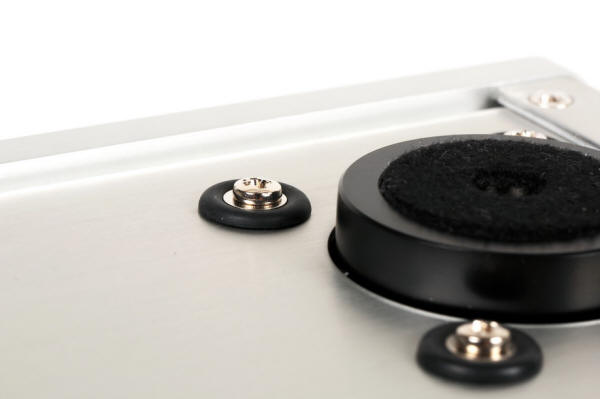
DESIGN
There is nothing about this device that could indicate it comes from Japan. It could as well be made in China. In fact nowadays many Japanese devices look like that. A solid design but not special about them.
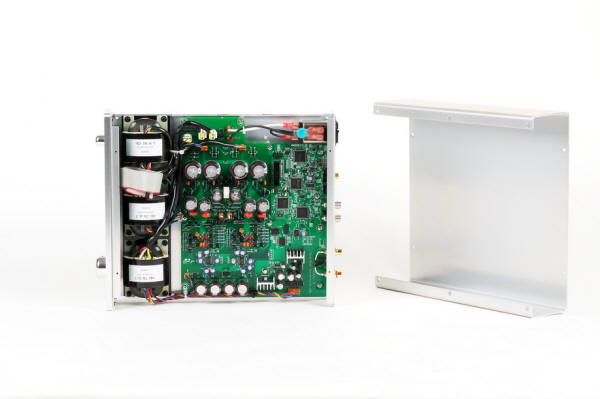
The casing was made of brushed aluminum. There are two nice knobs on the front of the device. One is input selector other allows user to activate K2 filter or only upsampling—by pushing it in—or change input sampling frequency by rotating it. I do not really understand how the latter function works and the manual quite purely translated to English doesn't really help. But the "manual problem" is quite common especially among small manufacturers. From what I understood user has to manually select sampling frequency if signal comes from a "home made" source. Any other device should automatically synchronize with DAC and rotating this knob doesn't affect the sound. Operation of K2 and upsampling (these two are connected) is indicated by a green LED, when only upsampling works a LED turns red. If non of these circuits works this LED does not work at all, and the other green LED indicates a selected input. There is also a LED that works if external master clock is used.

The back side of this device is pretty standard: RCA, USB and Toslink digital inputs, a pair of gold plated analogue outputs, a dedicated input for external master clock and a master clock output to connect it to CD Transport. There is also a IEC socket as Phasemation has w power supply integrated within the same casing.
The mechanical design is pretty good, although there is nothing special about it. Except maybe for one element—there are three feet, one supporting the back of the device, and two supporting front. The front feet are fixed to the bottom of casing and than through decoupling rubber washers with a Bakelite plate. On the other side of the same plate power transformers are fixed so all these elements seems to create a single "block" together. So in case one decides to use additional anti-vibration feet one should place them under feet, not just any place under the device.
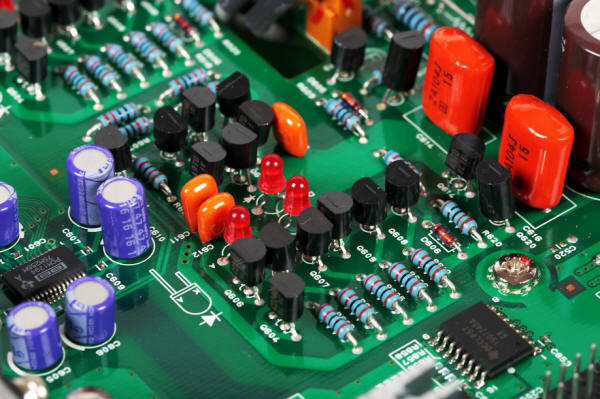
It might not look fancy but it is a solid design. It's built around quite advanced power supply section with 3 R-core transformer: two supply analogue section (right and left channel) and the third one powers digital stage. The latter has 5 separate secondary windings. Analogue section sports a rectifier based on Zener diodes. There are a lot of high quality capacitors. There are two, one per channel, Burr Brown PCM1974A DAC chips. The I/V conversion, analogue filters and output buffers are all based on transistors and not on integrated circuits. Manufacturer used high quality elements like metalized resistors, polypropylene capacitors, and purple Sanyo electrolyte capacitors that I've seen before a lot in many of the best digital devices.
The digital section combines several DSP and CMOS circuits. USB input delivers signal to XMOS chip that is capable of decoding signal up to 24 bit/192 kHz and converting it to PCM I2S signal. Next this signal (also signals from other two digital inputs) is sent to Analog Devices AD9852ASTZ DSP circuit. It seems to be a digital receiver with PLL loop that also sports digital filters and upsampling feature. Next there is an inconspicuous JCV8009 chip—it's a D/D converter that changer 16-bit words into 20-bit ones by interpolating additional bits (not by adding empty ones). Only than signal goes finally to DAC chip but not directly only via optocouplers—optical isolators separating these two sections.
An impressive design with lots of interesting ideas and good engineering involved.
Technical specification (according to Manufacturer)
Sampling frequency:
• USB – 44.1/48/88.2/96/176,4/192kHz | 16/24/32 bit
• RCA – 44.1/48/88.2/96/176,4/192kHz | 16/24 bit
• Toslink – 44.1/48/88.2/96kHz | 16/24 bit
Maximum output: 2 V rms
Channel separation: 105dB (10Hz – 20kHz)
S/N ratio: 110dB (10Hz – 20kHz)
Frequency response: 5Hz – 40kHz (+0, -2 dB, fs = 96kHz)
Distortions: 0.008% (1kHz, 0 dBfs)
Output impedance: 100Ω
Power consumption: 12W
Dimensions: 260 x 77 x 327mm (WxHxD)
Weight: 3.2kg
Price (in Poland): 15.990 PLN
Kyodo Denshi Engineering Co., Ltd.
http://www.kyododenshi.com
Ikebe-cho 4900-1 Tsuzuki-ku Yokohama-shi
Kanagawa 224-0053 | Japan
[email protected]
MADE IN JAPAN
Text and images by Wojciech Pacuła
Translation by Andrzej Dziadowiec







